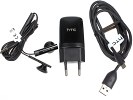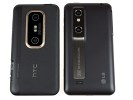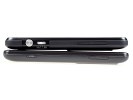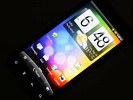An extra dimension
HTC EVO 3D review: An extra dimension

Retail package is good, but not perfect
The HTC EVO 3D is a high-end phone and as such you’d expect it to come with a pretty well stuffed box. It does deliver to a point: you get adequate storage in the form of an 8GB microSD card, there’s a microUSB cable to use for computer connections and with the charger head.
A single-piece headset completes what is by all standards a decent list. Yet, given the MHL connectivity of the EVO 3D, an HDMI cable would have certainly made sense. A carrying pouch would’ve also come in handy, in helping you protect your precious new smartphone.

The EVO 3D retail package contents
In fairness though, none of the competitors offers a better package so we won’t be taking any points away from the HTC EVO 3D.
HTC EVO 3D 360-degree spin
The glasses-free 3D screens are obviously still quite a bit of a stretch for smartphones at this point. The EVO 3D is nearly a millimeter thicker than the Sensation. In fact, at 126 x 65 x 12.1 mm, the 3D smartphone is the thickest of all dual-core smartphones currently on the market. The 170 grams of weight are quite a load compared to some of the competitors.
Design is impressive
The HTC EVO 3D is quite an imposing handset, and not without some distinct design accents. The huge screen is usually enough to make a smartphone a looker, but we have a black metal frame here to maximize the “wow” effect.
And even though the handset be quite large and heavy it is only 2 grams heavier than the Optimus 3D, which should be the first and most important point of reference. The LG smartphone is also just 0.2mm slimmer and a bit taller and wider than the HTC flagship so it’s pretty much a tie.



The EVO 3D and the Optimus 3D side by side
And the back of the EVO 3D is pretty cool too. It might be all plastic, but the pattern of fine diagonal lines gives it texture and looks good. Even the faux gold-painted frame surrounding the dual camera deck somehow fits in here. By the way, the pair of camera lenses curiously makes the whole thing look like a compact tape-recorder.
The exposed USB port on the left is probably the only design solution that we’re not particularly fond of, Overall though, we quite like the EVO 3D exterior. Had it been as slim as the Galaxy S II, the HTC new flagship would have been close to perfection.
3D screen left to do the talking
We now turn our attention to the HTC EVO 3D’s key feature, the stereoscopic LCD screen of qHD resolution (960 x 560 pixels). Just like with the LG Optimus 3D, you get the glasses-free stereoscopic effect using the parallax-barrier technology. That’s an extra screen layer that makes sure each eye sees a different set of pixels, giving a sense of depth.
The technology however does have a few downsides worth mentioning. For one, it only works in landscape mode and each eye gets only half of the screen’s horizontal resolution. Also, to be able to enjoy it fully you will need to find the sweet spot between your eyes and the handset's screen, which is different for everyone.

The 3D display is really what the EVO 3D is all about
Our subjective impression of the HTC EVO 3D screen is that the stereoscopic effect is slightly less dramatic than on the LG Optimus 3D. It’s just not as sharp, with less prominent depth. The difference is small and the HTC phone has a wider sweet spot: finding the ideal viewing position is easier. It might even be possible for two people to watch 3D content on the EVO 3D screen simultaneously – unthinkable on the LG Optimus 3D.
Still, even if a tad dampened, the 3D imaging is impressive. The downside is that it’s only enabled in the EVO 3D camera app and gallery. The Optimus 3D had a larger number of preinstalled apps optimized to use its 3D screen, which is quite important given the next-to-non-existent supply of third-party offerings at this stage.
It does 2D too
That said, 2D performance is actually the more important aspect of the EVO 3D’s screen. True, it will be the stereoscopic part that will be drawing crowds, but users will be stuck in two dimensions 90% of the time.
The good news is that the EVO 3D has a large and bright high-res screen. The bad news is the same could be said for most of its competitors. The qHD resolution and the ample 4.3” diagonal certainly give it an advantage, but its contrast is no match for the AMOLEDs or even the Reality and Retina displays out there.
Viewing angles aren’t perfect either – the EVO 3D does a lot better than the previous generation of HTC devices (Desire HD, Desire Z etc.), but it’s losing way more contrast when looked at an angle than an Incredible S, for example. It’s not bad enough to be a burden in everyday use. But it won’t produce the stunning effect of the icons appearing as if they’re painted on top of the screen that some of the competitors have.
Then again, most of those competitors aren’t doing 3D in their spare time and the only one that does is not doing that much better either. The LG Optimus 3D might have a bit better contrast and viewing angles, but the EVO 3D resolution advantage more than makes up for that.
And here come the HTC EVO 3D display test results so you can see how that one compares to its peers.
| Display test | 50% brightness | 100% brightness | ||||
| Black, cd/m2 | White, cd/m2 | Black, cd/m2 | White, cd/m2 | |||
| HTC EVO 3D | 0.26 | 184 | 719 | 0.65 | 495 | 761 |
| LG Optimus 3D | 0.22 | 226 | 1019 | 0.49 | 520 | 1068 |
| LG Optimus 2X | 0.23 | 228 | 982 | 0.35 | 347 | 1001 |
| Motorola Atrix 4G | 0.48 | 314 | 652 | 0.60 | 598 | 991 |
| HTC Sensation | 0.21 | 173 | 809 | 0.61 | 438 | 720 |
| Samsung I9100 Galaxy S II | 0 | 231 | ∞ | 0 | 362 | ∞ |

Tip us
1.9m 150k
RSS
EV
Merch
Log in I forgot my password Sign up